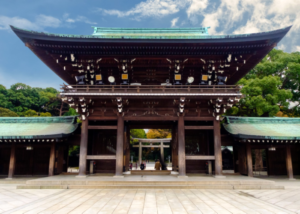- The Meiji-Jingu Shrine in Tokyo, the capital city of Japan, is enveloped by lush green woods located right in the heart of the city.

- The Shinto grand shrine is built in the memory of Emperor Meiji (1852-1912) and Empress Shoken, first emperor and empress of modern-day Japan.
- You can well put Meiji-Jingu at the top of your bucket list, in addition to visiting the busy Shibuya or Harajuku with a calm walk down the well-trodden pathway to the front gate of the shrine.
- Major attractions include the Treasure House filled with royal artifacts and antiques of the past; the traditional Inner Garden, a spiritual spot and the Spring Grand Festival of the shrine held during April – May.
- Come 2020, the shrine will commemorate its 100th anniversary, just before the Tokyo Olympics.
- You can find over 1,20,000 trees in the forest bordering the Meiji Jingu and Yoyogi Park. They cover a range of different species, which came as donations from all over the country.
- You can find English signage all over the place to help you take part in traditional Shinto rituals including giving offerings and doing prayers at the main hall, writing down your wishes on an ema amulet, and picking a protective charm or fortune.
- There are the iris gardens which were a favorite spot among emperors and empresses, and this tells you why Meiji-Jingu was constructed here.
- Although the garden involves an entrance fee, it’s well maintained comprising a lovely labyrinth of picturesque forest walks, traditional iris flowerbeds and there is that ritual Japanese tea house too.
- Kiyomasa’s Well got its name after the military general who dug it 400 years ago. Today, it is regarded by many as a ‘power spot’, a site visited by people to receive positive vibes and healing energy.
- The Meiji-Jingu Shrine grounds are a host to several festivals all along the year including Nikku-sai beginning on New Year, considered a ritual of good fortune, concluding as Joya-sai or ‘end-of-the-year-ritual’ on December 31st. The Spring Grand Festival is celebrated during April-May. Not to mention the traditional Shinto weddings happening during the same period, food fairs, modern fests, and traditional music and cultural performances.
To Visit Meiji-Jingu Shrine in Tokyo contact Emperor Traveline for Cost-Effective Tour Package.

